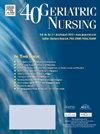社会认知理论下膝关节置换术患者运动恐惧的影响因素:结构方程模型
IF 2.5
3区 医学
Q3 GERIATRICS & GERONTOLOGY
引用次数: 0
摘要
目的:通过结构方程模型分析膝关节置换术患者运动恐惧影响因素之间的路径关系:通过结构方程模型分析膝关节置换术患者运动恐惧影响因素之间的路径关系:背景:运动恐惧的发生严重影响了膝关节置换术患者的康复过程。背景:膝关节置换术患者运动恐惧的发生严重影响了患者的康复进程,然而,仍有必要确定减少运动恐惧的因素:方法:在 2022 年 2 月至 2020 年 10 月期间,根据 STROBE 指南进行了一项横断面研究:在 2022 年 2 月至 2022 年 10 月期间,162 名全膝关节置换术(TKA)患者和 81 名单间室膝关节置换术(UKA)患者完成了一项调查。采用结构方程建模(SEM)方法分析了运动恐惧与影响因素(社会支持、疼痛恢复力和康复自我效能)之间的关系。此外,还进行了多组 SEM 分析,以检验该模型是否同样适合不同类型的膝关节置换术患者:结果:康复自我效能感(β = -0.535)和疼痛复原力(β = -0.293)对运动恐惧有直接负效应。疼痛复原力和康复自我效能感在社会支持和运动恐惧之间的中介效应(β = -0.183)也是显著的。SEM 模型达到了可接受的拟合程度(χ2 = 35.656,RMSEA = 0.031,χ2/df = 1.230,GFI = 0.972,NFI = 0.982,IFI = 0.997,CFI = 0.996)。在多队列分析中,膝关节置换术(TKA、UKA)之间未观察到显著差异(Δχ2 = 4.213,P = 0.648):结论:满意的社会支持可增强疼痛恢复能力和康复自我效能感,从而减少运动恐惧。未来直接针对运动恐怖症评估和管理的干预措施、可用的社会支持可能有助于减少运动恐怖症,而疼痛恢复能力和康复自我效能可能是管理运动恐怖症的关键因素:减少膝关节置换术患者的运动恐惧需要令人满意的社会支持、疼痛恢复能力和康复自我效能。因此,医疗机构可以通过考虑这些因素来减少运动恐惧。本文章由计算机程序翻译,如有差异,请以英文原文为准。
Influencing factors of kinesiophobia in knee arthroplasty patients under the social cognitive theory: A structural equation model
Objective
To analyze the path relationships among influencing factors for kinesiophobia in knee arthroplasty patients through a structural equation model.
Background
The occurrence of kinesiophobia significantly impacts the rehabilitation process of knee arthroplasty patients. However, there is still a need to determine factors that contribute to reducing kinesiophobia.
Design
A cross-sectional study was conducted and reported following the STROBE guideline.
Methods
Between February 2022 to October 2022, 162 total knee arthroplasty (TKA) patients and 81 unicompartmental knee arthroplasty (UKA) patients completed a survey. A structural equation modeling (SEM) approach was utilized to analyze the relationships between kinesiophobia and influencing factors (social support, pain resilience, and rehabilitation self-efficacy). Furthermore, multi-group SEM analysis was conducted to examine whether the model equally fitted patients in different types of knee arthroplasty.
Results
The direct negative effects of rehabilitation self-efficacy (β = −0.535) and pain resilience (β = −0.293) on kinesiophobia were observed. The mediating effect (β = −0.183) of pain resilience and rehabilitation self-efficacy between social support and kinesiophobia was also significant. The SEM model achieved an acceptable model fit (χ2 = 35.656, RMSEA = 0.031, χ2/df = 1.230, GFI = 0.972, NFI = 0.982, IFI = 0.997, CFI = 0.996). In multicohort analysis, no significant differences were observed among knee arthroplasties (TKA, UKA) (Δχ2 = 4.213, p = 0.648).
Conclusions
Satisfactory social support enhances pain resilience and rehabilitation self-efficacy, so as to reduce kinesiophobia. Future interventions that directly target the assessment and management of kinesiophobia, available social support may help reduce kinesiophobia, and pain resilience and rehabilitation self-efficacy may be critical factors in managing kinesiophobia.
Relevance to Clinical Practice
Reducing kinesiophobia in knee arthroplasty patients requires satisfactory social support, pain resilience, and rehabilitation self-efficacy. Therefore, healthcare organizations may implement initiatives to reduce kinesiophobia by taking these factors into account.
求助全文
通过发布文献求助,成功后即可免费获取论文全文。
去求助
来源期刊

Geriatric Nursing
医学-护理
CiteScore
3.80
自引率
7.40%
发文量
257
审稿时长
>12 weeks
期刊介绍:
Geriatric Nursing is a comprehensive source for clinical information and management advice relating to the care of older adults. The journal''s peer-reviewed articles report the latest developments in the management of acute and chronic disorders and provide practical advice on care of older adults across the long term continuum. Geriatric Nursing addresses current issues related to drugs, advance directives, staff development and management, legal issues, client and caregiver education, infection control, and other topics. The journal is written specifically for nurses and nurse practitioners who work with older adults in any care setting.
 求助内容:
求助内容: 应助结果提醒方式:
应助结果提醒方式:


